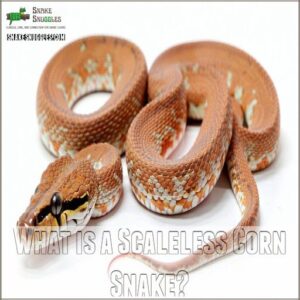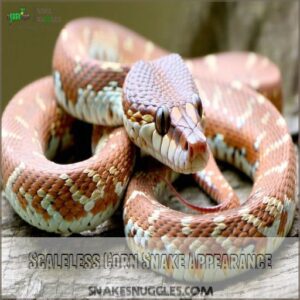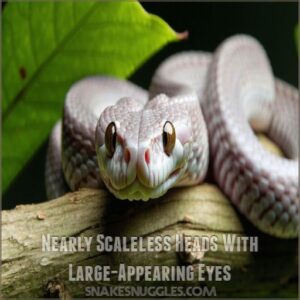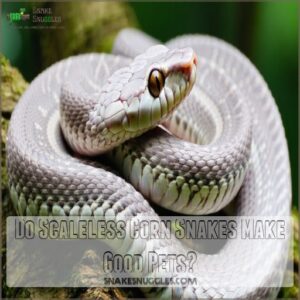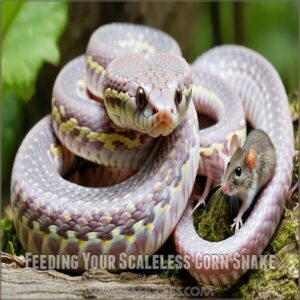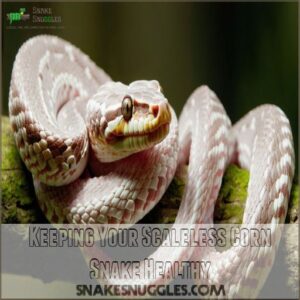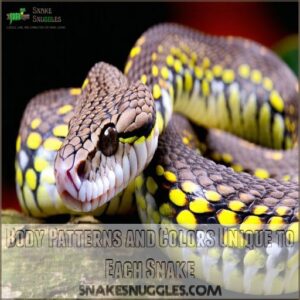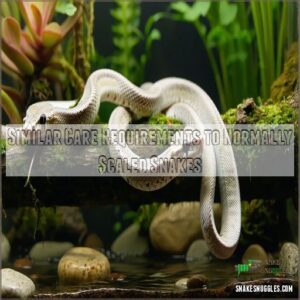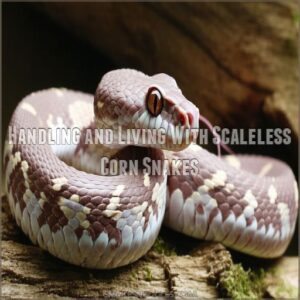This site is supported by our readers. We may earn a commission, at no cost to you, if you purchase through links.
 A scaleless corn snake is a fascinating reptile that lacks the typical scales found on most snakes, giving it an eye-catching, smooth appearance.
A scaleless corn snake is a fascinating reptile that lacks the typical scales found on most snakes, giving it an eye-catching, smooth appearance.
You’ll notice their skin feels silky, yet it wrinkles endearingly when they coil.
With eyes that seem to pop out like they’re perpetually surprised, these snakes almost look like living cartoon characters!
They can be bred in various morphs, such as scaleless albinos, adding more color and excitement to their charm.
While caring for one is like caring for regular corn snakes, you need to be gentle with their delicate skin.
Curious about these unique creatures? Stay tuned!
Table Of Contents
- Key Takeaways
- What is a Scaleless Corn Snake?
- What Do Scaleless Corn Snakes Look Like?
- Do Scaleless Corn Snakes Make Good Pets?
- Scaleless Corn Snake Care and Habitat
- Feeding Your Scaleless Corn Snake
- Keeping Your Scaleless Corn Snake Healthy
- Scaleless Corn Snake Breeding and History
- Unique Features and Traits of Scaleless Corn Snakes
- Handling and Living With Scaleless Corn Snakes
- Are Scaleless Corn Snakes Right for You?
- Frequently Asked Questions (FAQs)
- Are corn snakes the same thing as rat snakes?
- Is a corn snake and a chicken snake the same?
- Do corn snakes ever bite?
- Do corn snakes like sand?
- What are scaleless corn snakes?
- Do scaleless snakes have health issues?
- Can scaleless snakes survive?
- Are scaleless corn snakes ethical?
- How long do scaleless corn snakes live?
- Can scaleless corn snakes climb?
- Are scaleless corn snakes aggressive?
- How much do scaleless corn snakes cost?
- What are common scaleless corn snake morphs?
- Conclusion
Key Takeaways
- You’ll find scaleless corn snakes fascinating due to their smooth, silky skin and unique appearance, making them stand out among other snakes.
- Providing the right care for a scaleless corn snake involves maintaining proper humidity and a cozy environment to protect their delicate skin.
- Feeding involves frozen-thawed rodents to prevent injuries, along with a balanced diet and hydration to ensure their health.
- Scaleless corn snakes can be a rewarding pet choice, blending their striking looks with typical corn snake care needs, promising a captivating experience.
What is a Scaleless Corn Snake?
A scaleless corn snake is a unique reptile that’s missing the usual scales due to a genetic mutation, giving it a smoother, sometimes rubbery texture.
These snakes might be a bit unconventional in appearance, resembling a creature from a sci-fi movie, yet they offer the same vibrant patterns and colors as their scaled relatives.
Scaleless Corn Snake Morphs
Scaleless corn snakes‘ unique look comes from a cool genetic quirk.
You’ll find them in a rainbow of colors and patterns, thanks to the magic of breeding.
Think of it like a designer snake!
Scaleless Albino corn snakes are a vibrant orange-red, while Scaleless Tessera snakes have a broken pattern.
A Scaleless Anery looks more subdued, in shades of gray and brown.
The ghostly pale Scaleless Blizzard is another popular morph.
Scaleless corn snakes also require special care due to their delicate skin, including proper humidity levels and hiding spots.
These variations are all about different pigment combinations, not the absence of scales itself.
It’s like getting a custom-designed snake, but remember responsible breeding practices are key!
Scaleless Corn Snake Genetics
When considering a corn snake with a scaleless mutation, it’s all about blending genes to create unique morphs.
The scaleless gene acts recessively, meaning for a snake to lose its scales, both parents must carry this hidden trait.
Enthusiasts looking to care for such delicate snakes can find products specifically designed for scaleless corn snake morphs on websites like Scaleless Corn Snake Products.
While some breeders dream of novel designs, others question the ethics of breeding such delicate snakes.
Yet, they remain popular in the reptile community.
Imagine mixing paint on a canvas; that’s genetic diversity at work, constantly offering new colors and patterns for enthusiasts to explore.
What Do Scaleless Corn Snakes Look Like?
Scaleless corn snakes sport a sleek, velvety appearance that’s quite the conversation starter, and they’re known for their almost alien-like eyes, which seem larger without the usual scale border.
Their skin feels as smooth as silk, making them a unique reptile to handle and admire, though they might miss the sharp patterns seen on their scaly relatives.
Scaleless Corn Snake Appearance
Picture a scaleless corn snake and you’ll see its smooth, silken skin standing out with vivid colors and intricate patterns.
It’s like a living piece of art, thanks to various morph combinations.
The mutation reduces its scales, giving the snake a sleek texture.
Each corn snake displays unique color variations, making them fascinating scaleless reptiles among corn snake morphs.
Nearly Scaleless Heads With Large-Appearing Eyes
Imagine a scaleless corn snake with nearly scaleless heads and large-appearing eyes.
Their prominent eyes create a striking look.
Without protective scales, they’re more sensitive.
Understanding genetic variations in corn snakes is essential to appreciate the uniqueness of scaleless corn snakes.
Eye Protection: Without protective scales, they’re more sensitive.
Molting Issues: Keep humidity right to aid shedding.
Evolutionary Advantage? Their bug-eyed look is intriguing but adds challenges.
Soft and Silky Feel to Their Skin
Scaleless corn snakes have an alluring, almost magical feel.
Their skin, lacking traditional snake scales, offers a soft, silky texture that’s a delight to handle.
This unique trait makes them intriguing pets but requires careful handling to avoid damage, especially during molting.
| Feature | Consideration |
|---|---|
| Soft Texture | Unique feel |
| Appearance | Smooth, shiny skin |
| Molting | Requires care |
| Handling | Gentle touch needed |
Do Scaleless Corn Snakes Make Good Pets?
If you’re considering a scaleless corn snake as a pet, you’ll find they offer a unique and intriguing companionship without the typical scale issues.
Scaleless corn snakes need a cozy setup and a watchful eye to keep their soft skin in top shape.
Addressing Misconceptions About Scaleless Snake Ownership
Owning a scaleless corn snake might sound intimidating, but let’s squash some myths.
Many worry about their skin’s fragility; however, scaleless corn snakes’ thick skin actually offers surprisingly good protection.
They’re not delicate flowers!
Responsible breeding practices, like avoiding inbreeding, are key to healthy scaleless snakes.
With proper care, these unique snakes thrive as pets.
Understanding their specific needs guarantees a happy, healthy snake and a rewarding ownership experience.
Emphasizing Importance of Providing Suitable Housing
When setting up a home for your scaleless corn snake, think like a snake interior designer.
A tank size of 20-30 gallons is ideal, and your substrate choice matters—cypress mulch gives that comfy feel.
Create a nice temperature gradient from 70 to 88°F, add proper humidity levels, and make sure there’s good ventilation.
Your snake deserves a cozy and comfy habitat!
Preventing and Recognizing Skin Damage
Proper housing prevents skin issues in your scaleless corn snake.
Since their skin is delicate, you need to focus on maintaining humidity, avoiding abrasions, and preventing burns, while also being aware of the risks of skin conditions like snake scale rot causes.
Use low-wattage heaters safely away from contact.
Observing skin: Regular checks for damage help you to spot and treat problems early.
Treat your snake’s skin like you’d a favorite leather jacket.
Scaleless Corn Snake Care and Habitat
When setting up a home for your scaleless corn snake, you’ll need to replicate their natural environment with care and attention.
Make sure to provide a cozy tank, maintain the right temperature and humidity.
Avoid feeding them live prey to protect their delicate skin, because nobody wants a nibbling mishap!
Habitat, Tank Conditions & Setup
Time to nurture your scaleless corn snake’s habitat. Choose a comfy tank and create a cozy environment that mimics its natural home.
Use cypress mulch as a substrate, and make sure your snake has a roomy water bowl.
Tank Setup
Details
—————–
Temperature Gradient
Ventilation
Hiding Spots
Substrate Choices
Regular Misting for Humidity Maintenance
Humidity levels play a big role in keeping your scaleless corn snake comfy.
Regular misting can help maintain that sweet spot of 65-75%, ensuring your snake’s skin stays supple.
To track these levels accurately, consider investing in a humidity gauge specifically designed for reptile care, such as those found at a reptile humidity gauge.
Here’s the game plan:
- Mist twice weekly to keep that smooth skin smooth.
- Choose porous substrate to aid moisture retention.
- Monitor a water bowl’s fullness daily.
Special Dietary Requirements
While keeping your scaleless corn snake’s environment humid, don’t forget their special dining needs.
Ditch live prey due to skin risks; opt for frozen-thawed rodents instead.
They enjoy a varied diet, with calcium supplements to strengthen those delicate bones.
Remember, hydration is key, ensuring they drink up while savoring the nutrition.
Keep their meals as intriguing as their corn snake morphs!
Feeding Your Scaleless Corn Snake
You’ll need to feed your scaleless corn snake appropriately sized mice or rats, ensuring they’re frozen-thawed to prevent injury.
Feeding frequency depends on age; young snakes eat more often than adults, so adjust accordingly.
Diet and Nutrition Requirements
Feeding your scaleless corn snake is straightforward yet requires attention to detail.
Aim for a diet of appropriately sized mice or rats to make sure they’re getting the nutrients they need.
Keep an eye on their feeding schedule to avoid overfeeding, which can lead to obesity.
Supplement their diet with calcium to prevent deficiencies and support their bones.
Proper hydration is key too, as it aids their overall health and digestion.
Remember, keeping your corn snake happy means balancing its food, water, and nutrient needs carefully.
Feeding Frozen-Thawed Rodents for Optimal Health
Let’s nibble on feeding your scaleless corn snake right.
In terms of their diet, frozen-thawed rodents are your best bet for good health.
To make sure safe thawing, follow proper thaw frozen mice for snakes guidelines to prevent bacterial growth and contamination.
They also minimize injury, but they’re also packed with the nutritional value your snake needs.
Size matters here; pick prey that’s about the same size as the thickest part of your snake.
Feeding frequency is key—most adult corn snakes enjoy a rodent meal once a week.
Remember, a happy snake means a smooth-scaled friend slithering joyfully in its habitat.
Keeping Your Scaleless Corn Snake Healthy
To keep your scaleless corn snake in tip-top shape, it’s essential to recognize common health issues like respiratory problems and skin infections.
Regular check-ups with a reptile vet, maintaining appropriate humidity, and ensuring a proper diet are your best allies in preventing illnesses and promoting a happy, healthy snake.
Common Health Issues
Watch out for common health issues that your scaleless corn snake might face.
Respiratory infections can sneak up on you, much like dysecdysis, where shedding becomes tricky.
Keep an eye out for blister disease, pesky parasites, and the dreaded obesity.
These challenges can affect their health, so it’s key to stay vigilant in maintaining your snake’s well-being.
Prevention Measures
Keeping your scaleless corn snake healthy isn’t just about limiting issues—it’s about preventing them.
Think of skin infections, molting issues, and dehydration risk like unwanted guests.
A well-designed scaleless corn snake enclosure also plays a significant role in maintaining a clean environment.
You can help by:
- Maintaining ideal humidity and temperatures
- Providing a clean, cozy habitat
- Regularly inspecting their skin and eyes
These steps strengthen your scaleless snake’s defenses, ensuring they’re all scales—er, skin—and smiles!
Veterinary Care
To keep your scaleless corn snake in tip-top shape, regular vet check-ups are wise, especially if you spot signs like eye troubles or molting hiccups.
Watch for skin infections or pesky parasites since scaleless snakes might be more vulnerable.
Think of your vet as your snake’s health partner—always ready to tackle any twists and turns in reptile care!
Scaleless Corn Snake Breeding and History
You’ll discover how breeding these unique snakes works, including the genetics behind their scaleless trait and the fascinating history of their development.
Scaleless corn snakes have a surprising origin, from their first documented appearance to their increasing popularity among reptile enthusiasts.
Unlocking New Color and Pattern Combinations
Exploring new color and pattern combinations in scaleless corn snakes adds a splash of excitement to snake genetics.
Get into the world of designer morphs by breeding different genetic traits to experiment with:
- Color Mutations: Introduce vivid reds and subtle blues.
- Pattern Inheritance: Create unique striping or spotting.
- Ethical Breeding: Balance genetic diversity while considering snake welfare.
Developing Scaleless Snakes With Increased Popularity
So you’ve jumped into the colorful world of scaleless corn snake morphs, where breeding challenges and ethical considerations keep things interesting.
Market demand is up, as these unique snakes captivate enthusiasts.
With their irresistibly smooth skin and quirky appearance, these snakes are gaining traction, offering a fresh spin on snake genetics while sparking debates over future trends.
Captive Breeding of Scaleless Snakes
Captive breeding of scaleless corn snakes offers a fascinating look into genetic diversity and morph creation, relying heavily on understanding snake breeding genetics and inheritance.
Ethical considerations come into play as you balance health risks and breeding techniques.
By mixing various corn snake morphs, you can explore a vibrant palette of patterns and colors.
However, make sure you’re mindful of the potential challenges in snake breeding, including scaleless snake genetics.
Unique Features and Traits of Scaleless Corn Snakes
When you look at scaleless corn snakes, you’ll notice their unique and striking body patterns that differ from each other like snowflakes, with colors that seem painted right onto their smooth skin.
Despite their scaleless nature, they share similar care requirements with their scaly cousins, making them just as easy to keep—with a touch more style.
Body Patterns and Colors Unique to Each Snake
Scaleless corn snakes are like living art pieces, each with unique patterns and colors that make them stand out.
This is thanks to their genetic influences and breeding possibilities.
You’ll often see these vibrant scaleless morphs flaunting the following characteristics:
- Color Variation: From striking orange to soft pastels, the color palette is as diverse as a painter’s.
- Pattern Diversity: Expect patterns ranging from bold stripes to intricate mosaics.
- Genetic Influence: Each snake’s color and pattern is a reflection of its unique genetic makeup.
Each snake’s appearance is genuinely one-of-a-kind!
Similar Care Requirements to Normally Scaled Snakes
Caring for a scaleless corn snake isn’t all that different from looking after its scaled cousins.
You’ll still need a cozy enclosure, low-key UVB lighting, and a snug balance of temperature and humidity.
Regularly mist the tank to keep your snake comfy, and remember, their diet needs frozen-thawed rodents to thrive.
When handling, treat them gently to avoid skin damage.
Think of it like cradling a newborn!
These corn snakes, akin to their scaled relatives, are easygoing and rewarding companions.
Handling and Living With Scaleless Corn Snakes
You’ll find that handling your scaleless corn snake is surprisingly easy, just remember to support its body gently to avoid accidentally injuring its delicate skin.
Providing a safe, comfortable environment is key to a happy and healthy snake, ensuring a rewarding experience for both you and your unique pet.
Interacting and Handling Your Scaleless Snake Safely
Handling a scaleless corn snake is like holding a living, silky ribbon.
How gently you hold it can make all the difference in preventing skin damage.
Use safe handling techniques by letting the snake coil around your fingers, supporting its entire body with a gentle touch.
Pay attention to its mood—if it becomes restless, it might need a break.
Remember, scaleless snakes have more delicate skin, so always be mindful and calm during interactions.
These scaleless beauties will thank you for your care!
Providing Safe and Comfortable Environment
While bonding with your scaleless corn snake, ensuring their home feels cozy and secure is key.
A tank size of 20-30 gallons works well, with a temperature gradient between 70°F to 88°F.
Maintain humidity at 65-75% with regular misting for comfort.
Choose a soft substrate like cypress mulch to keep them happy and healthy.
Consider a safe handling spot where your snake can unwind.
After all, a well-prepared environment is like a snug blanket—it’s reassuring and peaceful for both of you.
Are Scaleless Corn Snakes Right for You?
Choosing a scaleless corn snake means committing to understanding their unique care needs, including maintaining proper humidity to support healthy skin.
They’re fascinating pets with a smooth feel, but be prepared for the long haul, as they can live over a decade with good care.
Factors to Consider Before Getting a Scaleless Corn Snake
Thinking about welcoming a scaleless corn snake into your home? It’s an exciting choice, but be sure to weigh a few key factors first.
- Ethical Considerations: Explore the debates around scaleless snake breeding.
- Care Complexity: These unique snakes need specific attention to environment and diet.
- Potential Health Risks: Consider the implications of their distinctive scaleless mutation.
- Breeder Reputation: Choose a reputable breeder who understands corn snake morphs.
Enjoy the adventure of caring for these fascinating reptiles!
Lifespan and Long-Term Commitment
Taking on a scal corn snake means embracing a lifelong adventure.
Typically, their longevity can stretch up to two decades with proper care.
Are you ready for this long-term commitment?
Consider factors like the snake care routine, responsible ownership, and ethical concerns.
It’s important to make sure you’re equipped to handle the corn snake’s needs throughout its lifespan.
So, before diving into this slithery companionship, ask yourself if you’re ready to make this scaly (or less scaly) pledge.
It’s a fulfilling, though slightly slippery, promise!
Frequently Asked Questions (FAQs)
Are corn snakes the same thing as rat snakes?
Imagine confusing lions with tigers—corn snakes and rat snakes are similar, yet distinct.
Corn snakes are a type of rat snake native to North America, known for their docile nature and vibrant patterns.
Is a corn snake and a chicken snake the same?
Corn snakes and chicken snakes are both names for certain rat snakes.
Corn snakes are commonly found in the U.S.
"Chicken snake" often refers to rat snakes that hunt chickens in barns.
They’re similar but not identical.
Do corn snakes ever bite?
Yes, corn snakes can bite, usually if they’re startled or feel threatened.
Their bites are typically harmless and more surprising than painful.
Handling them gently and regularly helps them feel safe and reduces the chances of biting.
Do corn snakes like sand?
Sand isn’t ideal for corn snakes as it can cause irritation or ingestion issues.
Cypress mulch is a safer and more natural substrate for corn snakes.
Cypress mulch provides a more comfy environment for your slithery friend.
What are scaleless corn snakes?
Ever wondered about snakes with surprisingly smooth skin?
These unique reptiles, lacking the usual scales, are called scaleless corn snakes.
A genetic quirk gives them a velvety texture, a cool look, and some unique care needs.
Do scaleless snakes have health issues?
Scaleless snakes typically don’t have unique health issues linked directly to their lack of scales.
They might face occasional molting challenges, but proper humidity helps.
Basic snake care applies, keeping them healthy and thriving in captivity.
Can scaleless snakes survive?
Yes, scaleless snakes can survive in the wild, although they might face challenges.
Their smooth skin lacks the typical protection of scales, making them more vulnerable.
But their adaptability often allows them to thrive despite this.
Are scaleless corn snakes ethical?
Picture holding a velvety rope, debating the ethics of breeding scaleless corn snakes parallels balancing beauty against potential health worries, like eye vulnerability.
It’s about weighing breeder passion against the snakes’ natural adaptability, breeding challenges, and survival.
How long do scaleless corn snakes live?
If you care for them properly, scaleless corn snakes can live 10 to 15 years or even longer.
Their lifespan depends on factors like genetics, diet, and habitat conditions, much like their scaly counterparts.
Can scaleless corn snakes climb?
Imagine a scaleless corn snake slinking its way up a branch.
They can climb using muscular movements and belly scales for grip, much like their scaled counterparts.
Just remember to create secure, enriching enclosures to prevent escapes!
Are scaleless corn snakes aggressive?
Scaleless corn snakes aren’t naturally aggressive.
They’re generally calm and curious, just like their scaled counterparts.
With proper handling and care, they make great, interactive pets that enjoy exploring their environment, though they appreciate gentle interactions.
How much do scaleless corn snakes cost?
You’ll find them ranging from $50 to $300, sometimes even more, depending on morph, breeder, and location. It’s a slippery slope, so shop around!
What are common scaleless corn snake morphs?
Common scaleless corn snake morphs include the vibrant Scaleless Albino, the uniquely patterned Scaleless Tessera, the muted Scaleless Anery, and the near-transparent Scaleless Blizzard.
Offering a wide range of colors and patterns for enthusiasts.
Conclusion
Plunging into the fascinating world of the scaleless corn snake, you’ll uncover a unique companion teeming with charm and character.
These snakes, with their distinct morphology and captivating smooth skins, are beautiful but easy to care for with the right setup.
Providing warmth, a suitable diet, and gentle handling will keep your scaleless corn snake thriving.
If you’re ready for this colorful adventure, these enchanting reptiles might just be the perfect pet for you!

